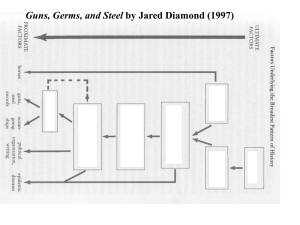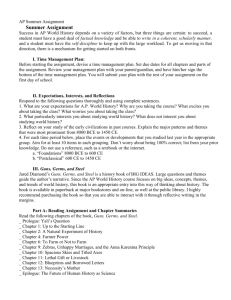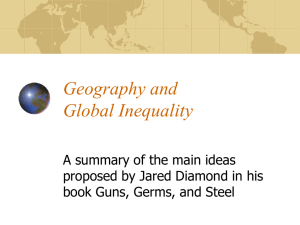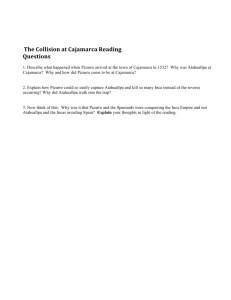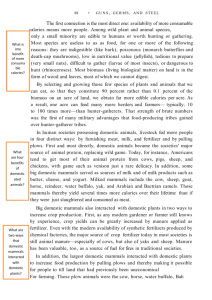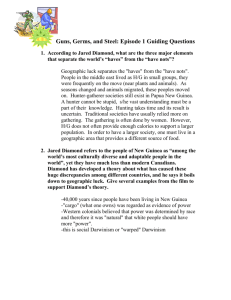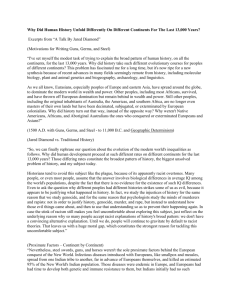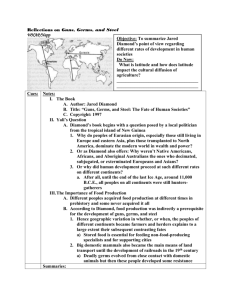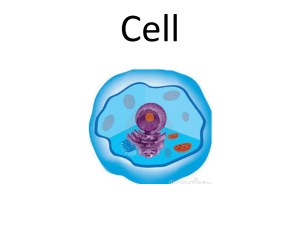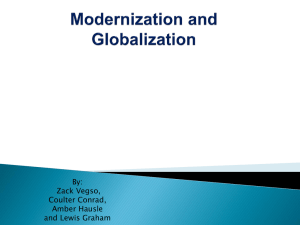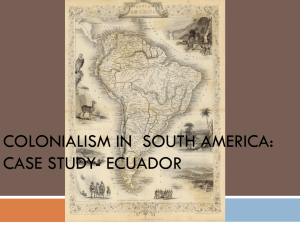Looking at Jared Diamond`s Guns, Germs, and Steel and alternative
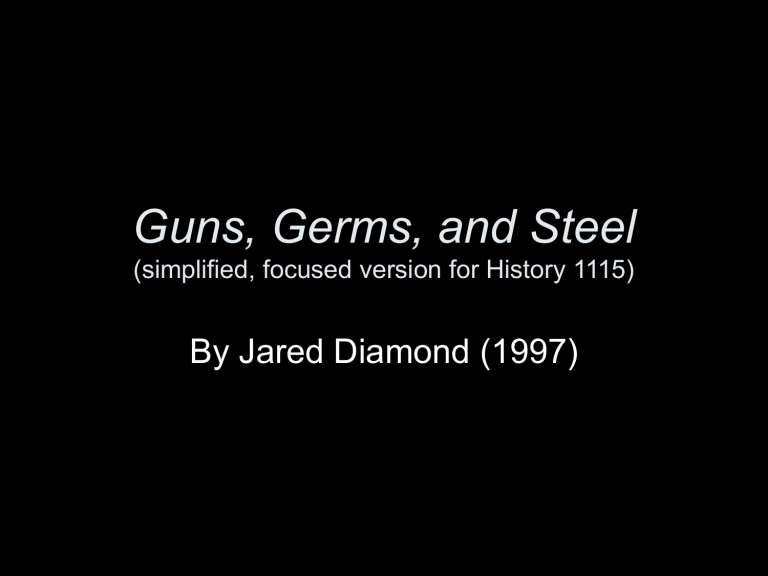
Guns, Germs, and Steel
(simplified, focused version for History 1115)
By Jared Diamond (1997)
Cover art:
Sir John Everett Millais,
Pizarro seizing the Inca of
Peru, 1845
The cover art actually says a lot about the way the
Western world looked at, and sometimes still looks at the conquest of the New
World.
Advance of
Christianity
Heroic
Conquistadors
Weak, effeminate, native leader
Frightened, superstitious natives.
• The painting reflects a firmly held belief that Europe conquered the world starting around 1500 AD because Europeans were simply better, smarter, etc. and ordained by God to conquer ignorant savages.
• This view, either consciously or subconsciously is still common.
• At some level, like most important questions of historical consequence, has intense political dimensions.
After all…
• “Why did Pizarro come to capture
Atahuallpa, instead of Atahuallpa’s coming to Spain to capture King Charles I?”
After all…
• Pizarro: 62 mounted soldiers.
• Pizarro: 106 infantrymen
Defeats:
• Atahuallpa: approx. 80,000 soldiers
?
• Doesn’t this point to European superiority?
The Spanish had an edge:
• Horses
• Steel (weapons and armor)
• Germs
• Writing
• Advanced technology: seafaring ships
Horses
• Horses are a big tactical advantage
• (Height, speed, size, terror factor)
• Indians don’t have horses
Like Mr. Ed
Actually…
• Other than the llama, the biggest domesticated animals in the New World at the time of European contact were small dogs.
Steel
• Edged Weapons and Armor made of steel
(swords, helmets, chain mail, lances, and a few harquebusier – early guns)
• Incas: stone weapons (obsidian) and armor made of quilted cotton.
Literacy & Writing
• Only native elites knew the complex Indian writing systems
• Confusion reigned supreme in the Incan army when Pizarro landed.
• Every Spanish raiding party had at least several literate members.
• Very important for planning and communication
Germs
• The Spanish carried lethal diseases with them that the Indians had never seen before to which they had no immunity.
• Disease actually got to the Incas a generation before Pizarro ever made it there. This created a massive disruption and a civil war in Incan society.
Technology
• Atahuallpa did not reach Spain because he did not have the ships.
• Though the Indian civilizations of Central and South America were technically advanced in many areas, ships were not one of them.
Government & Technology
• The Spanish Galleon was a pretty sophisticated ship in its day.
• Navigation aids.
Government
• It takes a lot of organization to send parties of men into the unknown.
?
• How did the Europeans come to possess all of these advantages?
• Is this just further evidence of European superiority?
Enter Jared Diamond…
• If we want to see how these societies became so different, we need to look at their roots.
• Guns, Germs, and Steel traces the development of world societies from ancient times.
• Let’s start by winding the clock back several thousand years….
Continental Axis
Jared Diamond:
Geography mattered:
1)Dictated the domesticable species available (plant and animal)
2)Dictated the ease at which they spread.
Continental Axis: Climate
Cold Winters
Warm mostly year-round
Tropical/Hot year-round
Temperature also stays more the same in the same longitude (eastwest) versus moving across latitude (northsouth)
Thus, crops that grow in
Western Russia will also grow in France. But crops grown in France will NOT grow in Libya.
Why does this matter?
• What Jared Diamond calls “Farmer
Power.”
• European and Eurasian societies had domesticable grain crops available to them that allowed a FRACTION of the population to feed ALL of the population.
• Continental axis allowed them to spread through Eurasia, but not elsewhere.
Toward Governments & Technology
• For instance, wheat and barley are very nutritious and yield a lot per acre.
• European societies grew larger because they had abundant food production
Toward Governments & Technology
• When the production of food only requires part of the population, there are people left over to become a ruling elite, artisans, engineers, etc.
• Ultimately you have division of labor and governmental structure. Chiefdoms, then kingdoms.
Continental Axis & Europe
• The geography of Europe and Western
Asia are conducive to the spread of these plant and animal species
• The geography of Africa (Sahara desert, jungles, large mountain ranges) is not. –
Many barriers, differing climates.
• Similarly, The Americas also had a northsouth orientation and were separated by an ocean from useful species.
Horses & Domestic animals
• A certain element of luck: the first domesticated horses came from Eurasia.
• In the New World, there simply weren’t the right type of animals to domesticate
• Not just horses, but food draft and food animals as well, Eurasia had an edge.
Some bad luck: Why not Africa?
• Africa, like the
Americas did not have the basic species capable of useful domesticity
• You cannot domesticate a Zebra, for instance, even though it looks kind of like a horse.
Domesticated Animals
• Domesticated animals also provide:
• 1) Labor (draft animals – mules, oxen)
• 2) Food (porkchops, steak, barbeque, hamburgers, bacon, sausage, filet mignon, pot roast, garlic braised leg of lamb, darn,
I’m getting hungry already!)
• 3) Transportation & War machines: horses
Animals & Disease
• Domestic animals are not the cleanest things in the world.
• Often living in very close proximity with humans, not to mention their own feces.
• Transmission of all kinds of crazy diseases.
Disease: Germs
Europeans: surplus of food = growing populations, more density of population.
greater density = living in close quarters with one another (diseases) living in close quarters with animals
(more diseases)
Europeans will contract many diseases over time. More importantly, they will also develop immunity to them.
Disease: Germs
• Disease will be a very critical element in the European conquest of the New World
• Valley of Mexico in 1450: 16 million people
• All of Mexico by 1600: 2 million people
• Smallpox, scarlet fever
Government & Technology
• Well fed, European populations grew large.
• Large numbers of people not involved in the production of food can dedicate their attention to other pursuits
• Large societies develop governments and literacy
Time
• Europe, and by extension, Eurasian society had built up its immunity to diseases, it societies, governments over several thousand years in isolation of the societies that they conquered.
European domination at 1500 AD
• Thus, genetic diversity + ease of spreading domesticable species of plants & animals along the continental axis allowed Europe especially to develop large societies.
• Biodiversity and proximity (and filth!) created disease and immunities
• Dense populations produced governments, technology, and desire to explore for new worlds.
Lastly
• Does this put the thesis of European superiority in a new light?
• The work of Jared Diamond in Guns,
Germs and Steel does not address everything, but is an interesting argument from the world of science.
